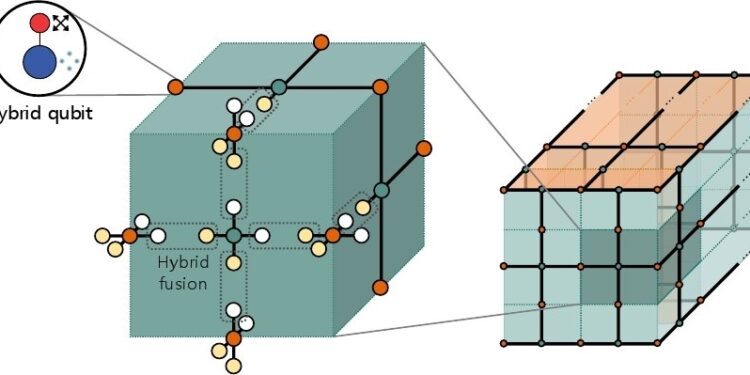Fault-tolerant quantum computing architecture using hybrid qubits / Fault-tolerant quantum computing architecture based on hybrid qubits that use DV and CV qubits simultaneously. It uses hybrid fusion techniques to connect hybrid qubits to form an error-correcting network structure. Credit: Korea Institute of Science and Technology
A major challenge in realizing quantum computers is the development of quantum error correction technology. This technology offers a solution to address errors that occur in the qubit, the basic unit of quantum computing, and prevents them from being amplified during calculation.
Without quantum error correction, it would be impossible for quantum computers to outperform their classical counterparts, and that is why efforts to advance this technology continue around the world.
Dr. Seung-Woo Lee’s research team from the Quantum Technology Research Center at the Korea Institute of Science and Technology (KIST) developed the world’s first hybrid quantum error correction technique for discrete variables (DV ) and continuous variables (CV), and designed a fault-tolerant quantum computing architecture based on a hybrid technique.
The results are published in the journal Quantum PRX.
Qubits implementing quantum error correction are called logical qubits and can be realized in two different ways: discrete variable (DV) and continuous variable (CV). Companies such as IBM, Google, Quera and PsiQuantum are developing quantum computers using the DV method, while Amazon (AWS), Xanadu and others are adopting the CV method. Each of these two approaches has advantages and disadvantages in terms of difficulty of handling and resource efficiency.
(a) The optical implementation of single-qubit spinning gates. (b) The teleportation patterns of hybrid qubits. Credit: Quantum PRX (2024). DOI: 10.1103/PRXQuantum.5.030322
KIST researchers proposed a method to integrate error correction of DV and CV qubits, which were previously developed separately. They developed a fault-tolerant architecture based on hybrid technology and demonstrated, through numerical simulations, that it combines the advantages of both methods, enabling more efficient and effective quantum computing and error correction.
Particularly, in optical quantum computing, the hybrid approach can achieve a photon loss threshold up to four times higher than that of existing techniques and improve resource efficiency by more than 13 times while maintaining the same logical error rate level.
“The hybrid quantum error correction technology developed in this study can be combined not only with optical systems, but also with superconductors and ion trap systems,” said Dr. Jaehak Lee from KIST.
“This research opens a new direction for the development of quantum computing,” said Dr. Seung-Woo Lee of KIST, who led the research. “Hybrid technologies integrating the advantages of different platforms are expected to play a crucial role in the development and commercialization of large-scale quantum computers.”
More information:
Jaehak Lee et al, Fault-tolerant quantum computing by hybrid qubits with Cat Bosonic code and single photons, Quantum PRX (2024). DOI: 10.1103/PRXQuantum.5.030322
Provided by the National Science and Technology Research Council
Quote: Hybrid quantum error correction technique integrates continuous and discrete variables (October 16, 2024) retrieved October 16, 2024 from
This document is subject to copyright. Except for fair use for private study or research purposes, no part may be reproduced without written permission. The content is provided for informational purposes only.



